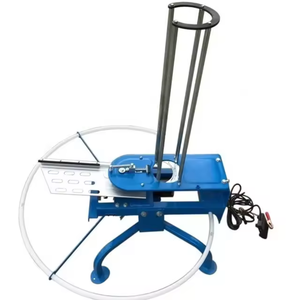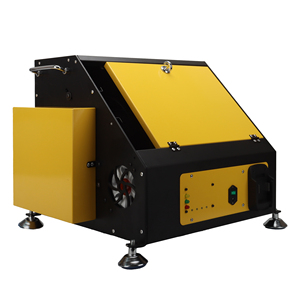(39 products available)



























































































































































The single rotor automatic throwers work by spinning one single disc to launch the clays. So, this type of thrower is suitable for economy and easy transport since it is compact. These are mainly used for shooting practice since they throw a limited range of clay targets at fixed angles.
These types of throwers are equipped with three or four launching discs to launch clay pigeons simultaneously or consecutively. It is appropriately used for advanced practice and full shooting competitions since they provide a greater variety of target presentations.
A battery-powered clay thrower is an ideal solution if there is no direct electric power source. Such a clay thrower can be very useful if it will be used in an area where there is no electric power or if the thrower needs to be transported and the weight of the petrol engine thrower is a concern. Various media can be used to launch clays. These include gas-powered, solar-powered, and battery-operated clay throwers.
With the usage of such different media, these throwers can help in launching the clays effectively without the constraints that come with the lack of a power source.
Clay throwers can be both manual and automatic. Such manual and automatic hybrid clay throwers are fixed, but they should be operated manually if required. This can be an advantage in practice since there can be a change from automatic launching to manual launching as required.
This is the case with automatic trap throwers. They consistently launch clays in a straight horizontal direction. Since automatic trap clay throwers are simple in design and can be automatic, they will be easy to use, maintain, and operate. They are commonly used in basic shooting practice and competitions because of their reliability and consistency.
Another type of thrower is necessary for skeet shooting since it involves a distinct clay pigeon trajectory. These throwers are also equipped with many launching discs. An automatic skeet clay thrower is used to provide the correct launching angles and speed required for skeet shooting.
Every one of these types of automatic rabbit feeders clay throwers is meant for different settings ranging from simple shooting practice to organized tournaments. Choosing the best {clay thrower} depends on the shooting discipline and the needs of the users.
The specific features of each automatic clay thrower vary, and so do the maintenance tips to keep each of them in perfect working condition.
Launch Rate
Different clay throwers have various launching rates, which are measured in clays per minute. Practice throwers normally have low launch rates, like 30 to 50 clays per minute. Competitive throwers will have higher rates, from 60 to 150 or more.
Power Source
Automatic clay throwers have battery, gas, or electric as their power source. Electric models are generally used indoors and should be operated by people who are conscious about time since their operation is continuous. Battery-powered throwers are mostly used outside if there is no electric power at the place. Clay throwers which are gas-powered are mostly for heavy usage since they provide more power and require more time to launch clays.
Angle and Distance Adjustable
Adjustable angles add both to the horizontal and vertical directions. The angle can be set by the user so that the clay will be launched in a particular direction at a given distance. The horizontal angle of the thrower is kept at ± 20°, while the vertical angle is ± 45° max. This feature permits a number of target presentations so that one can practice or compete in various circumstances.
Hopper Capacity
Hopper or reservoir will differ in size according to the clay pigeon thrower, with larger hopers meaning less frequent refilling. There are many throwers that hold up to 100 clays, while others can hold more than 300 clays. Larger hoppers are usually better for long sessions of shooting practice, where refilling can be time-consuming.
Clay Size and Type
The common sizes of clays are a 110 mm (standard) clay, a 90 mm (mini), and 110 mm (bio-degradable). Not all clay throwers will launch all types of clays. Some of them are even designed to throw other clays for different shooting games, such as {automatic trap clay pigeon thrower}s and {automatic skeet clay pigeon throwers}.
Regular Cleaning
It is important to make sure that clays do not get jammed inside the barrel of the thrower. It is also good to clean the parts that are likely to produce dust and other debris particulates.
Check Power Source
It should always be made sure that the batteries are changed, that electric cords are in good condition, and that gas engines maintain proper levels of fuel.
Lubrication
Some of the moving parts of a clay thrower should be lubricated according to the manufacturer's directions of doing it. Lack of lubrication may make the moving parts wear out faster.
Inspection of Belts and Cables
Worn thrower belts and cables can lead to reduced performance. It is good to check for any wear or tear and replace them as required.
Technological Update
One should not forget to be aware of any improvements brought by the manufacturers in the maintenance and operation of throwers. Some models may require firmware updates or other technological enhancements to improve their operation.
Most shooting ranges have automatic clay pigeon throwers, especially when it comes to shotgun shooting. Some common scenarios are trap, skeet, and sporting clays. The shooting range typically has electric or gas-powered clay throwers, which suck in a supply of electric power from the local grid or are self-sufficient with gas and clays like a commercial shooting range.
Automatic clay throwers at commercial shooting ranges are economical since these are designed for mass use. They allow the participants or shooters to improve their shooting skills while offering the shooters a better target diversity.
Coaching schools for clay shooters use automatic clay throwers to give a more structured training program. These schools commonly use a single rotor, multi-clay, and manual and automatic hybrid clay throwers.
They choose the type of automatic clay target throwers depending on the shooting disciplines that are intended to be taught and the level of the students. Training use throwers is probably the most scary thing for shooters because it allows them to prepare for detailed instructions for testing.
Local and regional clay pigeon shooting tournaments have automatic clay shooters to use in many different target presentations. After all, they are used in formal club competitions as well. Automated incidence ratio means that shooters do not have to place any clay manually and instead just focus on shooting.
Still, it does mean that the event can accommodate larger groups of shooters at once and may well do so without causing any additional time delays. The best example of automated clay shooters in sporting events is the automatic trap and skeet clay pigeon throwers.
Clay throwers can also be used in the course of shooting for field control and conservation activities. In these cases, portable and battery-operated clay throwers are mostly used because they are lightweight and simple to transport to various field locations.
Field shooting and conservation activities may include battery-powered manual and automatic clay throwers, basic field shooting practices, and often unpredictable shooting environments.
Most clubhouses and private estates that include shooting facilities will employ automatic clay throwers. A clubhouse might choose different sources of infection for its clay throwers. These can be either electric-powered throwers for reliable and easy indoor shooting or gas and battery-powered throwers for outdoor clay shooting.
They provide convenience and eliminate the need for manual loading for private shooters, which makes shooting less of a task and more of a fun activity for them.
The power source of the clay shooter is important to consider. If the shooter is to practice in a fixed position, then electric throwers would be ideal since they are easy to operate. However, for those who intend to do their shooting in various places, battery-powered or gas-powered throwers would be more suitable.
The clay thrower should be selected based on the type of shooting activity. The common types are automatic trap, automatic skeet clay pigeon throwers, and {sporting clay throwers}. A {clay trap thrower} is designed for horizontal shooting. An automatic skeet clay thrower is designed for short shooting towards curved lines. A sporting clay thrower is, therefore, complex and versatile since it throws the target in many different ways.
Automatic clay throwers come in different designs and prices. Electric shooters are cheaper than gas and battery-operated ones and might be more ideal as a starter option. Pro shooters will want more robust and costly shooters with multiple features. The shooter should determine how much they are willing to pay for the product before selecting one.
If the usage is going to be constant, then the hopper size will need to be larger so that fewer refills are made. The release rate should vary depending on whether the practice is for simple shooting or competitive shooting. Low release rates are ideal for general shooting, while large release rates are good for professional shooting.
The portability of the clay thrower is another consideration, especially if the clay thrower will frequently be moved from one location to another. Clay throwers that are battery-powered or gas-powered are better since they are easier to move. The electric ones are hard to move because they need to be plugged in somewhere. A good carrying case or bag will keep the clay thrower in operational condition.
Another factor to consider is how easy it is to adjust the throwing angle, target speed, and distance. Moving some parts to adjust the machine should be simple, especially during practice or competition. Various clay throwers come with knobs or levers that allow one to make quick adjustments without using tools. This feature is great for users who need to change target presentations on the spot.
A1: An automatic clay thrower is a device used in shooting sports to launch clay pigeons into the air. Clay throwers work by loading a clay pigeon into a throwing mechanism, usually a rotating wheel or arm, and then launching it at high speed. They can be powered by electricity, gas, or batteries, providing consistent and precise launches for training and competitions.
A2: The advantages of using an automatic clay thrower include improved shooting consistency because the clay targets are released with the same speed and angle each time. This helps shooters develop better technique and accuracy. Also, it reduces the need for manual throwing, allowing shooters to focus more on their practice.
A3: The typical range of an electric automatic clay thrower varies based on the model and settings but commonly launches clay pigeons from 50 to 100 yards. Some advanced throwers can adjust the launch angle and power to increase this range, making them suitable for different shooting needs.
A4: Yes, many clay throwers are designed to be versatile and can be used for both trap and skeet shooting. They do this by having adjustable settings for the type of target presentation needed for each game. However, specific throwers made for each discipline may offer more tailored target throws.
A5: To maintain a clay thrower, first, clean it regularly to remove any clay debris or buildup. Check moving parts for wear and apply lubricant as needed. If it’s battery-powered, ensure the battery is in good condition. For gas-powered models, clean the engine area and check fuel lines. Following the manufacturer's maintenance schedule also helps keep it in good working order.